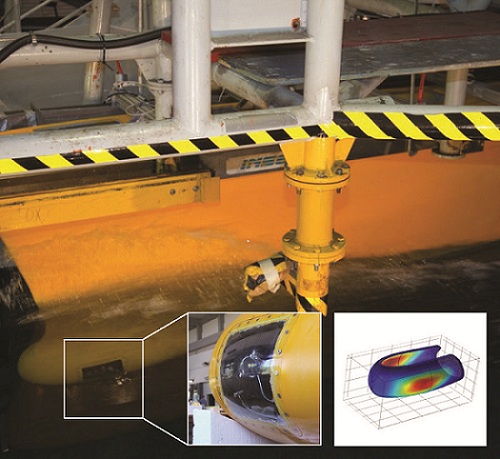
Starting the design process by testing on a small scale is often the best way to tackle issues affecting large objects, like a ship. Detailed in COMSOL News 2013, researchers at INSEAN, The Italian Ship Model Basin, used small-scale testing and then simulation to analyze the effect of placing a sonar system within the bulbous bow at the hull of a ship. Using a small-scale model of a bulbous bow, the researchers at INSEAN performed fluid-structure interaction experiments, and subsequently created a simulation model to validate an experimental-numerical procedure at the model size. Afterwards, they created a full-scale model within COMSOL Multiphysics using an in-house program as input to account for the size scaling. Interfacing LiveLink™ products were also used to manage external CAD data and integrate COMSOL Multiphysics with the in-house program. The full-scale model analyzed the structural, fluid, and acoustic properties that would impact the sonar system housed in the bulbous bow, as well as provided a framework for future researchers to expand upon.
Combining Bulbous Bows and Sonar Domes
First introduced in the early 1900’s, bulbous bows have become a mainstay in both large and small commercial ships to reduce drag and increase fuel efficiency. Bulbous bows protrude from the front of a ship, just below the waterline, and create a wave that partially cancels out the waves formed by the bow of the ship. These protrusions have various shapes and sizes, but are usually cylindrical with a dome at the end, forming a tear-drop shape. Commercial ships with bulbous bows usually have 12% greater fuel efficiency than ones without. In recent years, there has been increasing interest in housing sonar systems in bulbous bows, thus transforming them into actual sonar domes. Research into the effects of the structural vibration interference on the transducer array inside the sonar dome is a complex task and much is yet to be done to create optimized designs. INSEAN sought to compile the necessary information to make this design possible by evaluating the noise and vibration level in the sonar dome.
Integrating Experimentation and Simulation
Performing tests on a full-size ship would be extremely time consuming and costly, and would have required a very large facility. Instead, INSEAN researchers performed their experiments on a 1:8 scale model. They conducted two experiments to measure the wall pressure fluctuations along the bulbous bow and to determine the structural response of part of the bulbous bow. After these results were obtained, the team shifted to the simulation portion of their research endeavor.

A 1:8 scale model of the bulbous bow. A section has been substituted with an elastic linear material, and a simulation showing the structural response that would impact the sonar dome.
The first order of business involved creating a simulation model to match the results of the experiments performed on the scale model. After validating the experimental-numerical procedure for the scale model, they used an in-house program that solves Reynolds Averaged Navier-Stokes (RANS) equations to re-scale the wall pressure fluctuations measured on the small model. From these results they were able to obtain excitation data for the full-scale model. A boundary condition was then used as input for a COMSOL Multiphysics model that tested the impact of various velocities on the sound pressure level within the sonar dome.
The research team created a multidisciplinary tool to evaluate the performance of sonar sensors. Their broader scope was to integrate their work with other disciplines to create a tool that others can use in future research projects in order to achieve an optimized sonar dome design with respect to materials, drag, and vibration levels.
Further Reading
For more information about the research done by INSEAN, go to page 42 of COMSOL News 2013.




Comments (0)